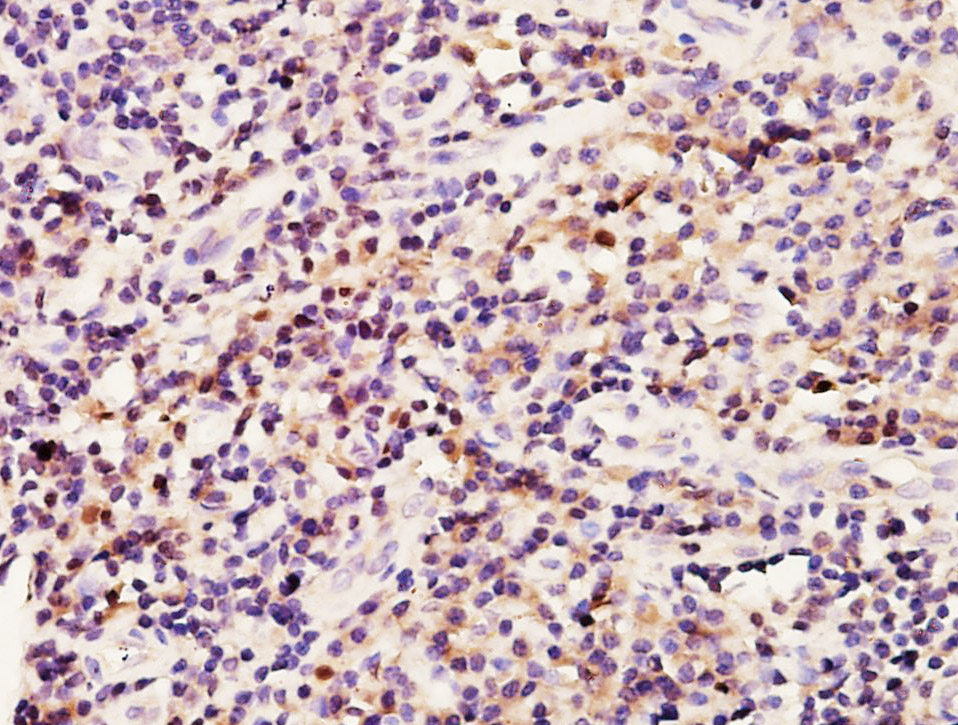BRCA1 antibody [8F7]
GTX70113
ApplicationsImmunoPrecipitation, Western Blot, ImmunoHistoChemistry, ImmunoHistoChemistry Paraffin
Product group Antibodies
ReactivityHuman, Mouse
TargetBRCA1
Overview
- SupplierGeneTex
- Product NameBRCA1 antibody [8F7]
- Delivery Days Customer9
- Application Supplier NoteFor IHC-P: Use at an assay dependent dilution. Perform heat mediated antigen retrieval before commencing with IHC staining protocol (0.1 M citrate buffer at 95C in water bath for 20 min). Avoid nonspecific binding by incubating in normal rabbit anti-mouse serum. Incubate primary antibody overnight and use a biotin-streptavidin amplification kit. Block endogenous peroxidase with 0.3% H2O2 for 30 minutes. For IP: Use at an assay dependent dilution. For WB: 1:500-1:3000. This antibody recognizes full-length BRCA1, a 220-kDa nuclear phosphoprotein. Optimal dilutions/concentrations should be determined by the researcher.
- ApplicationsImmunoPrecipitation, Western Blot, ImmunoHistoChemistry, ImmunoHistoChemistry Paraffin
- CertificationResearch Use Only
- ClonalityMonoclonal
- Clone ID8F7
- Concentration1 mg/ml
- ConjugateUnconjugated
- Gene ID672
- Target nameBRCA1
- Target descriptionBRCA1 DNA repair associated
- Target synonymsBRCAI, BRCC1, BROVCA1, FANCS, IRIS, PNCA4, PPP1R53, PSCP, RNF53, breast cancer type 1 susceptibility protein, BRCA1/BRCA2-containing complex, subunit 1, Fanconi anemia, complementation group S, RING finger protein 53, breast and ovarian cancer susceptibility protein 1, breast cancer 1, early onset, early onset breast cancer 1, protein phosphatase 1, regulatory subunit 53
- HostMouse
- IsotypeIgG1
- Protein IDP38398
- Protein NameBreast cancer type 1 susceptibility protein
- Scientific DescriptionThis gene encodes a nuclear phosphoprotein that plays a role in maintaining genomic stability, and it also acts as a tumor suppressor. The encoded protein combines with other tumor suppressors, DNA damage sensors, and signal transducers to form a large multi-subunit protein complex known as the BRCA1-associated genome surveillance complex (BASC). This gene product associates with RNA polymerase II, and through the C-terminal domain, also interacts with histone deacetylase complexes. This protein thus plays a role in transcription, DNA repair of double-stranded breaks, and recombination. Mutations in this gene are responsible for approximately 40% of inherited breast cancers and more than 80% of inherited breast and ovarian cancers. Alternative splicing plays a role in modulating the subcellular localization and physiological function of this gene. Many alternatively spliced transcript variants, some of which are disease-associated mutations, have been described for this gene, but the full-length natures of only some of these variants has been described. A related pseudogene, which is also located on chromosome 17, has been identified. [provided by RefSeq, May 2009]
- ReactivityHuman, Mouse
- Storage Instruction-20°C or -80°C,2°C to 8°C
- UNSPSC12352203
References
- Lanna A, Vaz B, D'Ambra C, et al. An intercellular transfer of telomeres rescues T cells from senescence and promotes long-term immunological memory. Nat Cell Biol. 2022,24(10):1461-1474. doi: 10.1038/s41556-022-00991-zRead this paper
- Dacheux E, Vincent A, Nazaret N, et al. BRCA1-Dependent Translational Regulation in Breast Cancer Cells. PLoS One. 2013,8(6):e67313. doi: 10.1371/journal.pone.0067313Read this paper
- Bosviel R, Durif J, Déchelotte P, et al. Epigenetic modulation of BRCA1 and BRCA2 gene expression by equol in breast cancer cell lines. Br J Nutr. 2012,108(7):1187-93.Read this paper
- Turner NC, Lord CJ, Iorns E, et al. A synthetic lethal siRNA screen identifying genes mediating sensitivity to a PARP inhibitor. EMBO J. 2008,27(9):1368-77. doi: 10.1038/emboj.2008.61Read this paper
- Lee MN, Tseng RC, Hsu HS, et al. Epigenetic inactivation of the chromosomal stability control genes BRCA1, BRCA2, and XRCC5 in non-small cell lung cancer. Clin Cancer Res. 2007,13(3):832-8.Read this paper
- Al-Mulla F, Abdulrahman M, Varadharaj G, et al. BRCA1 gene expression in breast cancer: a correlative study between real-time RT-PCR and immunohistochemistry. J Histochem Cytochem. 2005,53(5):621-9.Read this paper
- Bernard-Gallon DJ, Dechelotte PJ, Le Corre L, et al. Differential expressions of BRCA1 and BRCA2 in infantile gynecomastia. Anticancer Res. 2004,24(1):321-4.Read this paper
- Ongusaha PP, Ouchi T, Kim KT, et al. BRCA1 shifts p53-mediated cellular outcomes towards irreversible growth arrest. Oncogene. 2003,22(24):3749-58.Read this paper
- Reed W, Sandstad B, Holm R, et al. The prognostic impact of hormone receptors and c-erbB-2 in pregnancy-associated breast cancer and their correlation with BRCA1 and cell cycle modulators. Int J Surg Pathol. 2003,11(2):65-74.Read this paper
- Okada S, Ouchi T. Cell cycle differences in DNA damage-induced BRCA1 phosphorylation affect its subcellular localization. J Biol Chem. 2003,278(3):2015-20.Read this paper


